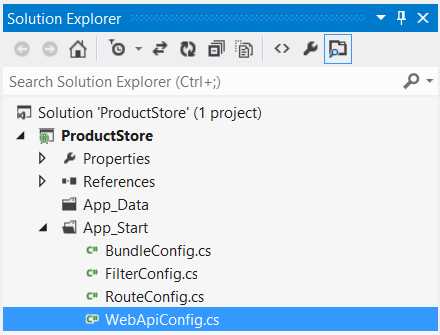标签:
本文介绍了ASP.NET Web API路由HTTP请求控制器。
如果你熟悉ASP.NET MVC,Web API路由是和MVC路由非常相似的。主要差别是Web API使用HTTP方法而不是URI路径来选择Action的。你也可以使用MVC的路由配置风格来配置Web API路由,当然本文不是来介绍ASP.NET MVC的。
在ASP.NET Web API,控制器是一种处理HTTP请求的类。控制器的公共方法被称为动作方法或简单的动作。当Web API框架接收请求时,它将请求发送到一个动作。
要确定调用哪个动作,该框架使用路由表。Visual Studio项目模板为Web API创建了一个默认的路由:
routes.MapHttpRoute(
name: "API Default",
routeTemplate: "api/{controller}/{id}",
defaults: new { id = RouteParameter.Optional }
);
这个路由在位于App_Start文件夹中的WebApiConfig.cs文件中定义:

如果想要知道更多相关的配置,你可以访问Configuring ASP.NET Web API .
如果是自主机Web API,你必须设置路由表直接在HttpSelfHostConfiguration对象.想知道更多相关信息,请访问Self-Host a Web API.
路由表中的每一个条目包含一个路由模板。Web API默认的路由模板是"api/{controller}/{id}". 在这个模板中, "api"是固定路径量, {controller} 和 {id} 都是预置位变量.
当Web API框架接收到一个HTTP请求,它将尝试匹配URI对路由表中的路由模板。如果没有匹配到,客户端将收到一个404错误。例如,可以用下列地址来匹配默认的路由规则:
但是,下面这个路径将匹配不到,因为它缺少了"api"这个固定路径量:
Note: The reason for using "api" in the route is to avoid collisions with ASP.NET MVC routing. That way, you can have "/contacts" go to an MVC controller, and "/api/contacts" go to a Web API controller. Of course, if you don‘t like this convention, you can change the default route table.
Once a matching route is found, Web API selects the controller and the action:
Let‘s look at an example. Suppose that you define the following controller:
public class ProductsController : ApiController
{
public void GetAllProducts() { }
public IEnumerable<Product> GetProductById(int id) { }
public HttpResponseMessage DeleteProduct(int id){ }
}
Here are some possible HTTP requests, along with the action that gets invoked for each:
| HTTP Method | URI Path | Action | Parameter |
|---|---|---|---|
| GET | api/products | GetAllProducts | (none) |
| GET | api/products/4 | GetProductById | 4 |
| DELETE | api/products/4 | DeleteProduct | 4 |
| POST | api/products | (no match) |
Notice that the {id} segment of the URI, if present, is mapped to the id parameter of the action. In this example, the controller defines two GET methods, one with an id parameter and one with no parameters.
Also, note that the POST request will fail, because the controller does not define a "Post..." method.
The previous section described the basic routing mechanism for ASP.NET Web API. This section describes some variations.
Instead of using the naming convention for HTTP methods, you can explicitly specify the HTTP method for an action by decorating the action method with the HttpGet, HttpPut, HttpPost, or HttpDelete attribute.
In the following example, the FindProduct method is mapped to GET requests:
public class ProductsController : ApiController
{
[HttpGet]
public Product FindProduct(id) {}
}
To allow multiple HTTP methods for an action, or to allow HTTP methods other than GET, PUT, POST, and DELETE, use the AcceptVerbs attribute, which takes a list of HTTP methods.
public class ProductsController : ApiController
{
[AcceptVerbs("GET", "HEAD")]
public Product FindProduct(id) { }
// WebDAV method
[AcceptVerbs("MKCOL")]
public void MakeCollection() { }
}
With the default routing template, Web API uses the HTTP method to select the action. However, you can also create a route where the action name is included in the URI:
routes.MapHttpRoute(
name: "ActionApi",
routeTemplate: "api/{controller}/{action}/{id}",
defaults: new { id = RouteParameter.Optional }
);
In this route template, the {action} parameter names the action method on the controller. With this style of routing, use attributes to specify the allowed HTTP methods. For example, suppose your controller has the following method:
public class ProductsController : ApiController
{
[HttpGet]
public string Details(int id);
}
In this case, a GET request for “api/products/details/1” would map to the Details method. This style of routing is similar to ASP.NET MVC, and may be appropriate for an RPC-style API.
You can override the action name by using the ActionName attribute. In the following example, there are two actions that map to "api/products/thumbnail/id. One supports GET and the other supports POST:
public class ProductsController : ApiController
{
[HttpGet]
[ActionName("Thumbnail")]
public HttpResponseMessage GetThumbnailImage(int id);
[HttpPost]
[ActionName("Thumbnail")]
public void AddThumbnailImage(int id);
}
To prevent a method from getting invoked as an action, use the NonAction attribute. This signals to the framework that the method is not an action, even if it would otherwise match the routing rules.
// Not an action method.
[NonAction]
public string GetPrivateData() { ... }
This topic provided a high-level view of routing. For more detail, see Routing and Action Selection, which describes exactly how the framework matches a URI to a route, selects a controller, and then selects the action to invoke.
原文地址:http://www.asp.net/web-api/overview/web-api-routing-and-actions/routing-in-aspnet-web-api
标签:
原文地址:http://www.cnblogs.com/ziranquliu/p/4703840.html